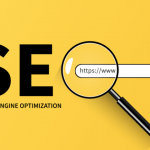Principles of Web Design for Developing Successful Websites
by admin
| March 25, 2024
Understanding web design principles, including HTML and CSS, is crucial for creating a customized website that suits your business’s needs. Even if professional designers are involved, being involved in the design process allows for valuable input, resulting in a customized website that meets your needs of Company.
Simple yet Elegant design
A website’s ability to perform and remain visually appealing requires a clean, straightforward design. To do this, think about the following advice:
1. For element alignment and organization, select a grid-based structure. 2. Avoid unnecessary visuals, text, and page features, but do not cut back on essential content. The personality of the brand should be reflected in the images. 3. Limit the number of typefaces used across the website to three and make sure they are easy to read and optimized for the online. 4. Select a color scheme that enhances the brand’s identity and lends it unique appeal. Users may get eyes bored and overwhelmed by too many or too strong of colors. 5. Use three to five colors across the website; a three-color palette should adhere to the 60-30-10 rule. 6. Highlight key material to transform the negative, or space, between graphic design into a positive.
In conclusion, a well-designed layout may produce a visually appealing and useful website. Simplicity is essential in website design.
Easy access of the Website
A website’s design should be user-centric to facilitate rapid and simple navigation for users. Users can be guided toward content by employing a simple structure such as the F or Z pattern and visual hierarchy. Creative call-to-action buttons should be placed near the user’s pointer using Fitt’s law, making them bold and visible. These features of design make it easier and faster for people to find what they’re looking for. Successful design examples are the Z pattern used by Apple and Facebook. In general, the layout ought to be simple and focused on the user.
Designing Websites to Be Easy to Use
• User-centric design for easy and quick access to content.
• Put visual hierarchy to use in content guidance.
• Use logical structures like the F or Z patterns, which are based on widely used text scanning techniques.
• To make a statement, use creative call-to-action buttons.
• Make the CTA bold and place it close to the user pointer by using Fitt’s law.
Balanced web design
Proportionate visual weight distribution is necessary for achieving balance in website design. For simplicity, symmetry can be utilized, such as bilateral, radial, or translational symmetry. Translational symmetry and almost symmetrical designs have certain uses. Although asymmetrical designs can be complicated, they can also result in eye-catching compositions that improve the site’s aesthetic appeal.
The layout of the navigation should be straightforward, rational, and accessible from a variety of devices. It ought to have a clear, accurate language, be easily navigable on various devices, and be prominently displayed. There should only be eight navigation objects, and they should be arranged according to priority.
Give Easy Options
The Hick-Hyman Law, also referred to as Hick’s Law, states that consumers may take longer to make judgments due to the quantity and complexity of options, which may drive them to bounce or leave the website. Websites can offer filters or fewer options to enhance user experience, as seen in e-commerce websites.
Analysis of website
Make your website accessible to those with limits, challenges, and weaknesses. In addition to being humanitarian, this will help your company grow by attracting more customers and opening up new markets. A few examples of accessibility elements are alt text for photos, screen reader labeling, avoiding small font sizes, and having enough color contrast between the foreground and background. Likewise, make sure your website is user-friendly to everyone, as this enhances the perception of your company and reflects your beliefs.
Responsive Design
Mobile devices are becoming more and more popular for accessing websites, with tablets being a popular option. Websites should be visually appealing and easy to use on all platforms to guarantee a mobile-friendly experience. A responsive design makes a website more accessible and user-friendly by dynamically adjusting text, graphics, and other elements according to the size of the device.
Quick Load time
Page speed optimization should be given top priority in website design to lower user rejection. Ensuring a rapid load time and optimizing file sizes can greatly enhance user experience. A large number of people expect that a website will load in two seconds or less, and if it takes longer, they may leave.
Suitable Objective
Every page on the website should have a separate objective, and the design should reflect this. Companies want to be found online, interact with customers, build relationships, and make more money, thus the design needs to be appropriate for this particular use case.
Visual Regularity
For a website to be designed effectively, color schemes, typefaces, and layout must all be consistent. It guarantees both functional and visual consistency, which makes your brand and website appealing and memorable.
In a nutshell
In order to set your website apart from the competition, the essay stresses how important it is to include fundamental web design ideas. It indicates that, following an unpleasant experience, 88% of users will never return to a website, 75% of people rely on their opinion of a company’s legitimacy on its website, and 94% of critical comments are related to the website’s design. A thoughtfully designed website can improve user experience, make a good first impression, and promote lead conversion.
 Development Services
Development Services Technologies
Technologies ICO
ICO ICO Marketing
ICO Marketing










